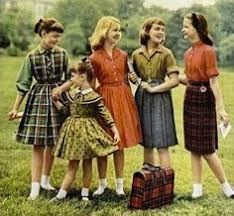I want to continue to explore the differences children experienced based on the decade they were born into. Today, we explore the 1950s and compare their life with those of the children in the 1940s. The blog post about growing up in the 1940s can be found here.
Since I was born in this decade, I was interested to research how other children may have experienced this decade. I found that my experience was quite different from my peers because my family was an Air Force family and we lived overseas most of my childhood. That said, let's look at what history says was the norm for children growing up in the 1950s.
The Experience:
Growing up on the 50s was characterized by many traditional values, such as respect for authority, hard work, and discipline. The experience varied across differing socioeconomic status and cultural background, but still there were commonalities.
Children in the 50s spent most of their free time playing outside in yards, streets, and public areas. These children were very physically active and liked to ride bikes, roller skate, or play ball of some kind. They played chase, tag, jumped rope, did hopscotch, played marbles just as the children of the 40s did. When inside, they might play cards, board games, work puzzles, play with dolls or toy cars.
Since television was still in its infancy, not all families had a television set. Those who did would watch programs such as "The Lone Ranger", "The Mickey Mouse Club", or "I Love Lucy". Viewing these programs was very much a family activity with the whole family sitting together in the living room.
Theaters were popular and on weekends the children and their families might go see the newest film out, but this was a special occasion due to the cost of tickets, and food at the theater. Sometimes, families would have to wait to see these films until they had saved the money for the entire family to attend.
The children of the 50s were readers. Trips to the library were fun outings for the family. They enjoyed many books about adventure, mysteries and animals; they had favorite authors like Dr. Seuss, Beverly Cleary and others. Reading was encouraged as an activity for times when physical actions were not possible.
Over all, this was a time of great emphasis on family and community. Family life centered around a nuclear family that consisted of a father, mother and children. Gender roles were well defined and everyone knew what was expected from them. Children were expected to obey their parents and show respect for authority figures like their teachers.
The Differences Between the 1940s and 1950s:
The children of the 40s had lives dominated by the presence of war. The were, very early on, exposed to the realities of war and knew rationing and air-raid drills. Because of their unique situation, they may have experienced anxiety and the uncertainty brought by wartime.
Their family life was different in that the extended family was included more. The grandparents, aunts and uncles, and family friends all took part in helping to raise children and help make ends meet. People in the 40s had to rely on each other to get through the war years when things were scarce or hard to find.
Children were expected to do their part to aid with the war effort and they collected old tires, metal, and money to help with our war effort overseas. They were very aware of the cost of war in both money, things, and people as many had family or friends serving overseas; many had lost important people to the war.
Due to wartime shortages, toys and entertainment options were more limited in the 40s. Children often made do with homemade toys or played outside with friends under the watchful eyes of the neighborhood. Instead of watching television, although it had been invented in the 40s, they would listen to the radio for news and for entertainment. Shows like "The Green Hornet", "Fibber McGee and Molly", "Jack Benny Show", "The Fred Allen Show" were family favorites and the whole family sat in the room together to listen to them.
Books read by the youth of the 40s usually had a thread in them about the war. They helped to promote patriotism and the virtues of sacrifice and hard work. Children read books like "The Boxcar Children" and "Little House on the Prairie" when they had spare time.
Conclusion:
Although children are always children no matter the decade, there are some differences between each decade's youth. In this case, the 40s children were responsible, respectful, dependable, and worked hard to help their families. While the 50s children were able to be more relaxed and act more like children. They were allowed to play like children do and they were encouraged to be strong and independent. They also were respectful, dependable and resilient, but they were not expected to work to support their families.
Each decade comes with it's own set of problems. At the end of the 50s there was the Cold War. During this time, children did experience anxiety and practice drills, but not to the extent of the 40s. Families were mainly intact since there was no active war activity ongoing, so children in the 50s experienced a different type of family life.
Both decades produced strong, dependable, patriotic, and respectful children who would grow up to be good citizens and to work hard to support the countries economy.











